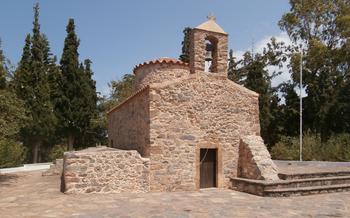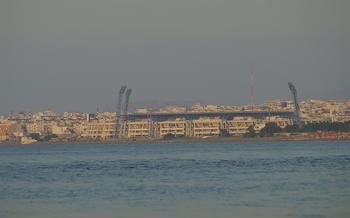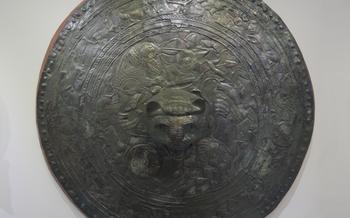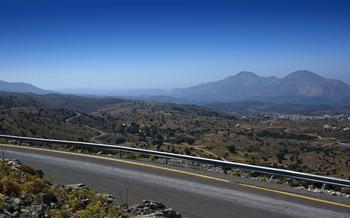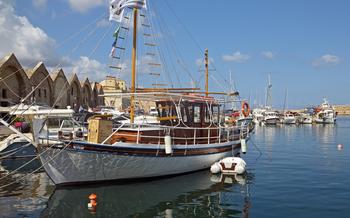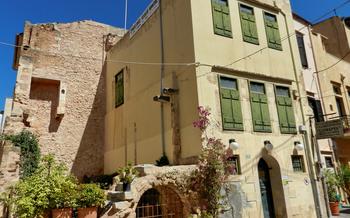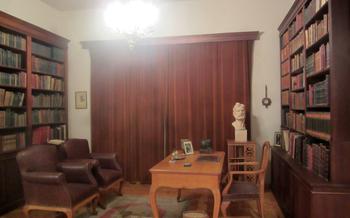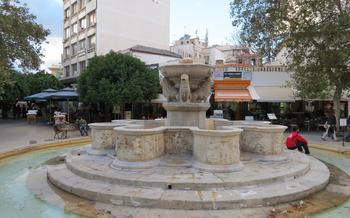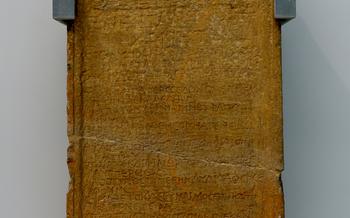
Dikteon Cave (Psychro Cave)
- Dikteon Cave (Psychro Cave)
- Location
- History and Mythology
- Exploring the Cave
- Minoan Artifacts
- Stalactites and Stalagmites
- Religious Significance
- Archaeological Museum of Heraklion
- Festivals and Events
- Hiking and Nature Trails
- Local Cuisine and Hospitality
- Accommodation Options
- Photography and Videography
- Sustainable Tourism Practices
- Insider Tip
Dikteon Cave (Psychro Cave)
The Dikteon Cave, also known as Psychro Cave, is a natural wonder steeped in mythology and archaeological significance. According to Greek mythology, it was here, in the depths of this sacred cave, that Zeus, the king of the gods, was born and raised. The cave's historical significance extends beyond mythology, as archaeological excavations have unearthed a wealth of Minoan remains and artifacts, shedding light on the religious practices and rituals of this ancient civilization.
The cave's natural beauty is equally captivating, with its intricate formations of stalactites and stalagmites creating a mesmerizing subterranean landscape. The harmonious interplay of light and shadow within the cave's chambers adds to its ethereal atmosphere, inviting visitors to step back in time and experience the mystical aura that has enveloped this site for centuries.
Location
The Dikteon Cave, also known as the Psychro Cave, is situated in the Lasithi region of Crete, a captivating Greek island renowned for its rich history and stunning natural landscapes. This remarkable cave is conveniently located just 40 kilometers from the vibrant city of Heraklion, the island's capital, and a mere 25 kilometers from the picturesque town of Agios Nikolaos. Its proximity to these major urban centers makes it easily accessible for visitors seeking an immersive exploration of Crete's cultural and natural treasures. Additionally, the cave is well-connected by a comprehensive road network, ensuring a smooth and hassle-free journey for travelers.
History and Mythology
The Dikteon Cave, steeped in the mists of time, holds a profound significance in Greek mythology and Minoan history. According to ancient beliefs, this sacred grotto served as the birthplace and sanctuary of Zeus, the almighty king of the gods. Mythological tales recount how the infant deity was hidden in the cave to safeguard him from his father, Cronus, who devoured his own children out of fear of being overthrown. Nurtured by the goat-nymph Amalthea and guarded by the Kouretes, a band of divine warriors, Zeus grew up in the cave, developing his extraordinary powers.
Beyond its mythological associations, the cave played a pivotal role in Minoan civilization. The Minoans, an advanced Bronze Age culture that flourished on Crete, revered the cave as a sacred site and conducted religious rituals within its hallowed chambers. Archaeological excavations have unearthed an array of Minoan artifacts, including votive offerings, pottery, and ritual objects, attesting to the cave's religious significance during this era. These findings provide valuable insights into the beliefs and practices of the Minoan civilization, shedding light on their spiritual world and connection to the divine.
Exploring the Cave
Delve into the depths of the Dikteon Cave, embarking on a guided tour that unravels its secrets and unveils its hidden wonders. Tours are conducted in multiple languages, ensuring that visitors from all corners of the globe can immerse themselves in the cave's rich history and natural beauty.
As you journey through the cave's chambers and passages, marvel at the intricate formations of stalactites and stalagmites. These natural sculptures, shaped by the patient work of water over millennia, create a surreal and awe-inspiring landscape.
The average duration of a tour is approximately 45 minutes, providing ample time to explore the cave's various chambers, admire its unique features, and learn about its significance from knowledgeable guides.
Minoan Artifacts
The Dikteon Cave, aside from its religious significance, has also yielded a wealth of Minoan artifacts, providing valuable insights into the ancient civilization's beliefs and practices. Excavations have uncovered a diverse array of pottery, ritual objects, and frescoes, each holding a unique story.
Pottery: The discovered pottery spans various styles and types, from simple utilitarian vessels to elaborately decorated ceremonial pieces. These artifacts offer a glimpse into the daily lives and rituals of the Minoans, shedding light on their culinary habits, storage practices, and artistic preferences.
Ritual Objects: Numerous ritual objects have been found within the cave, including libation vessels, offering tables, and figurines. These artifacts suggest that the Minoans engaged in various religious ceremonies and rituals within the cave, seeking divine favor and protection.
Frescoes: While frescoes are not as abundant as in other Minoan sites, the cave does feature a few well-preserved examples. These paintings depict scenes of religious significance, such as offerings to deities or processions of worshippers. The vibrant colors and intricate details provide a glimpse into the artistic prowess of the Minoan civilization.
Stalactites and Stalagmites
The Dikteon Cave is renowned for its impressive stalactites and stalagmites, which have been formed over thousands of years through a fascinating natural process. Water seeping through the cave's limestone ceiling dissolves minerals, creating droplets that hang from the ceiling. As these droplets evaporate, they leave behind tiny deposits of calcite, gradually forming stalactites. Over time, these stalactites grow downwards, sometimes merging with stalagmites rising from the cave floor, creating awe-inspiring columns.
The cave boasts a diverse array of stalactites and stalagmites, ranging from delicate, needle-like formations to massive pillars that resemble ancient sculptures. Each formation is unique, displaying a variety of shapes and sizes, adding to the cave's captivating beauty.
To preserve the cave's pristine natural beauty, strict conservation efforts are in place. Visitors are advised to follow designated pathways and refrain from touching or damaging the formations. By respecting these guidelines, we can ensure that future generations can continue to marvel at the wonders of the Dikteon Cave.
Religious Significance
The Dikteon Cave holds immense religious significance, deeply rooted in ancient Minoan beliefs and Greek mythology. For the Minoans, the cave was a sacred sanctuary, a place of worship and ritual practices. They believed that the cave was the birthplace and childhood home of Zeus, the king of the gods, who was raised by the goat-nymph Amalthea. Archaeological evidence suggests that the Minoans performed various rituals and ceremonies within the cave, leaving behind offerings such as pottery, figurines, and votive objects.
Over time, the cave's religious significance evolved, and it became a place of pilgrimage and worship for people from across the Greek world. In classical Greek mythology, Zeus remained associated with the cave, and it was believed that he frequently visited the site. The cave's religious importance continued into the Roman period, and even today, it holds a special place in the hearts of many Greeks.
Archaeological Museum of Heraklion
The Archaeological Museum of Heraklion, located in the capital city of Crete, houses a treasure trove of artifacts from the Dikteon Cave, providing an extended understanding of the cave's significance. Among the exhibits are pottery fragments showcasing various styles and decorative motifs, offering glimpses into the artistic traditions of the Minoan civilization. Ritual objects, crafted from different materials, reveal the religious practices that took place within the cave. Additionally, captivating frescoes depict mythical scenes and provide valuable insights into the beliefs and mythology of the Minoans. Visiting the Archaeological Museum of Heraklion complements the experience of exploring the Dikteon Cave, allowing visitors to delve deeper into the historical and cultural context of this sacred site.
Festivals and Events
Dikteon Cave is not only a place of historical and archaeological significance but also a vibrant hub for cultural celebrations and events. Throughout the year, the region comes alive with festivals and events that honor the cave's rich history and mythology.
One of the most notable events is the annual Dikteon Cave Festival, held in the summer months. This festival is a vibrant showcase of Cretan culture, featuring traditional music, dance, theater performances, and storytelling sessions. Visitors can immerse themselves in the local traditions and experience the warmth and hospitality of the Cretan people.
During the festival, the cave itself becomes a stage for cultural performances, with musicians, dancers, and actors bringing the ancient myths and legends to life. The atmosphere is electric as the cave's natural acoustics amplify the sounds and enhance the performances.
Participating in these festivals and events is an excellent way to gain a deeper understanding of the cave's cultural significance and to connect with the local community. Embrace the opportunity to immerse yourself in the rich tapestry of Cretan traditions and create lasting memories of your time in Heraklion.
Hiking and Nature Trails
Beyond the historical and archaeological significance of the Dikteon Cave, visitors can immerse themselves in the natural beauty of the surrounding Lasithi Plateau. An array of hiking trails offers opportunities to explore the diverse landscapes, ranging from easy paths suitable for families to more challenging routes for experienced hikers.
Strolling along these trails, one can admire the stunning scenery, dotted with traditional villages, lush vegetation, and panoramic views. The trails wind through olive groves, vineyards, and fields, providing a glimpse into the agricultural heritage of the region.
Combining nature and history, these hiking trails lead to hidden gems such as abandoned settlements, ancient churches, and natural springs. Hikers can discover the rich biodiversity of the area, encountering a variety of flora and fauna, including endemic species.
Exploring these trails is an ideal way to connect with the natural surroundings of the Dikteon Cave and gain a deeper appreciation for the region's cultural and environmental heritage.
Local Cuisine and Hospitality
Immerse yourself in the authentic flavors of Crete at the tavernas and restaurants near the Dikteon Cave. Savor traditional dishes prepared with fresh, local ingredients, such as "dakos" (barley rusks topped with tomatoes, feta cheese, and olive oil), "gamopilafo" (wedding pilaf with lamb or goat), and "kalitsounia" (cheese-filled pastries). Enjoy the warm hospitality of the locals as they share stories and anecdotes about the cave's history and mythology. Engage in lively conversations, learn about Cretan customs, and experience the genuine spirit of this welcoming community.
Accommodation Options
When planning your visit to the Dikteon Cave, you'll have a range of accommodation options to choose from, ensuring a comfortable and memorable stay.
-
Nearby Hotels and Guesthouses: For those seeking convenience, there are several hotels and guesthouses located close to the cave, offering a variety of amenities and services. These accommodations provide easy access to the cave and the surrounding attractions, allowing you to maximize your time exploring the region.
-
Village Charm: To fully immerse yourself in the Cretan culture and experience traditional hospitality, consider staying in one of the nearby villages. These charming villages offer a range of guesthouses and small hotels that exude local character and provide a glimpse into the authentic Cretan lifestyle.
-
Planning Your Stay: To ensure a hassle-free experience, it's advisable to book your accommodation in advance, especially during the peak tourist season. Online platforms and local travel agencies can assist you in finding the best deals and availability. Whether you prefer modern amenities or a more traditional Cretan experience, you'll find suitable options to complement your visit to the Dikteon Cave.
Photography and Videography
The Dikteon Cave offers a photographer's paradise, with its captivating formations and enchanting atmosphere. To capture the cave's splendor, consider the following tips:
-
Lighting conditions: The best time to photograph the cave is during the early morning or late afternoon, when the natural light illuminates the stalactites and stalagmites, casting dramatic shadows and creating a magical ambiance.
-
Composition: Experiment with different angles and perspectives to create visually compelling shots. The cave's intricate formations provide endless opportunities for creative compositions.
-
Tripod: A tripod is essential for capturing sharp and steady images, especially in low-light conditions. It allows you to experiment with longer shutter speeds, capturing the ethereal beauty of the cave's natural formations.
-
Respect the environment: While capturing the cave's beauty, remember to respect the fragile environment. Avoid using flash photography, as it can disturb the cave's delicate ecosystem and damage the formations.
-
Capture the essence: Beyond capturing the visual beauty of the cave, try to capture its essence and atmosphere. Incorporate elements of history, mythology, and spirituality into your shots to convey the cave's profound significance.
Sustainable Tourism Practices
Preserving the heritage of Dikteon Cave requires responsible tourism practices that minimize environmental impact and support local communities. Visitors are encouraged to adhere to designated trails, refrain from touching or damaging cave formations, and dispose of waste properly. Embracing eco-friendly practices, such as using reusable water bottles and reducing plastic consumption, contributes to the cave's sustainability.
Supporting local communities involves engaging with local businesses, such as family-run tavernas and guesthouses, which offer authentic experiences and contribute to the local economy. Respecting local customs and traditions, promoting cultural heritage, and purchasing locally made products further support sustainable tourism initiatives.
By adopting responsible tourism practices, visitors can actively contribute to the preservation and protection of Dikteon Cave while promoting sustainable development and benefiting the local community. Together, we can ensure that future generations can continue to explore and appreciate this remarkable natural and cultural wonder.
Insider Tip
Venture beyond the well-trodden paths and discover the hidden gems of Dikteon Cave. Explore the lesser-known chambers and passages, where the stalactites and stalagmites create awe-inspiring formations that seem frozen in time.
For an unforgettable experience, visit the cave during the off-season, when the crowds have dispersed and tranquility reigns. Immerse yourself in the cave's mystical atmosphere, free from distractions, and let your imagination soar as you contemplate the stories it holds.
To truly unlock the secrets of Dikteon Cave, consider hiring a local guide. These knowledgeable individuals possess a wealth of stories and insights that will bring the cave's history and significance to life. They can lead you to hidden corners, reveal ancient inscriptions, and share captivating tales of the myths and legends that surround this sacred place.
